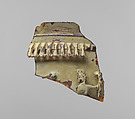Glass cage cup fragment
Translucent honey brown, appearing olive green in reflected light.
Flaring rim, with tapering lip; convex curving side to body; five bridges support the high relief decoration on the body.
On exterior, a single raised horizontal line below rim; an openwork band at top of side, comprising a frieze of vertical darts, of which eleven are preserved intact or in part, flaring out and downwards, each with upward V-shaped cut decoration; on main part of body, figural decoration, attached by slender bridges, of which only the upper part of one figure survives: at right, a standing male, identified as a satyr but possibly Dionysos, with head turned in profile to left, bare upper chest, and left arm outstretched and holding a long staff or thrysos; at left, small part of unidentifiable object or figure.
Part of rim, broken on sides and below, with weathered edges; creamy weathering covering most of surfaces, some surface pitting of pinprick bubbles, and small patches of iridescence.
Cage cups comprise a rare group of late Roman luxury glassware that was decorated with openwork designs in deep relief, usually in geometric patterns, less frequently in figural scenes. The most unusual type, as represented by this fragment, combines figures—part of a satyr is visible here—with a special effect known as dichroism, created by the composition of the glass. Minute particles of gold and silver have been added to the glass to make it appear to be two different colors, olive green in reflected light and reddish amber in transmitted light. Although the surviving length of rim is only 1 3/16 in. (3 cm), the rim diameter can be estimated to be about 7 1/16 in. (18 cm). The fragment therefore belongs to a large bowl rather than a cup or beaker.
Due to rights restrictions, this image cannot be enlarged, viewed at full screen, or downloaded.
This artwork is meant to be viewed from right to left. Scroll left to view more.





